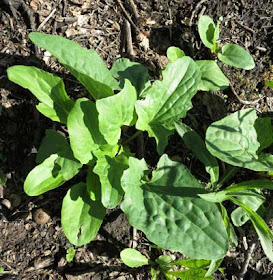From now until early June we'll be spraying. Any bad forb is being sprayed with aqueous Garlon 3A. This includes thistles, dandelion, English plantain, motherwort, garlic mustard (yes, we have a small amount of this), and two native species that are clonal and highly invasive: pale Indian plantain (PIP) and sunflower. Right now, most of our effort is on PIP, which starts early and sends up massive numbers of root suckers.
Because we burned the Crane Prairie last November, this was the first site we worked on, but now it has been a month since our first spring burns, so any area that is in full sun is a target.
 Yesterday I spent most of the day on a relatively small area (1.1 acres) that had historically been a prairie remnant and is recovering nicely. However, although it has many good species, it is heavily infected with PIP, with plants ranging from substantial rosettes down to little root suckers just barely large enough to see. I set up a set of swaths across this unit and carefully moved back and forth spraying any PIP. (A few bramble resprouts were also up and got sprayed, but we'll have to return in a few weeks for an all-out effort on them.)
Yesterday I spent most of the day on a relatively small area (1.1 acres) that had historically been a prairie remnant and is recovering nicely. However, although it has many good species, it is heavily infected with PIP, with plants ranging from substantial rosettes down to little root suckers just barely large enough to see. I set up a set of swaths across this unit and carefully moved back and forth spraying any PIP. (A few bramble resprouts were also up and got sprayed, but we'll have to return in a few weeks for an all-out effort on them.)One of the challenges in this work is that there are several good species whose leaves might be mistaken for PIP. Although I wanted to move quickly through the area, I wanted to be certain that none of these good plants were sprayed. Two in particular were fairly prolific and had leaves that, at a quick glance, might be mistaken for PIP.
 One of these is zig-zag goldenrod (Solidago flexicaulis), which is one of the earliest plants to appear in our savannas. As the photo shows, the leaves of this goldenrod are serrate, whereas those of PIP are entire, but you have to be sure to look at them carefully. Since there is lots of zig-zag goldenrod in this unit, if I sprayed one or two by mistake it would not be a major tragedy.
One of these is zig-zag goldenrod (Solidago flexicaulis), which is one of the earliest plants to appear in our savannas. As the photo shows, the leaves of this goldenrod are serrate, whereas those of PIP are entire, but you have to be sure to look at them carefully. Since there is lots of zig-zag goldenrod in this unit, if I sprayed one or two by mistake it would not be a major tragedy.The other species, which needs even more careful attention, is shooting star (Dodecatheon meadii), which is very prolific in this unit. The photo below shows this species and PIP side by side. This particular shooting star plant had a flower stalk, which helped, but most of these plants have not started to flower yet. I worked fairly hard to keep from spraying any of these plants. (The large population of shooting star in this unit is new this year, and they almost certainly have come from seed that was planted 6 or 7 years ago.)

This photo also shows a number of PIP root suckers that are just coming up (the tiny plants just above the large PIP leaves). We try to spray all of these plants also, but will almost certainly miss some, in addition to those that are not out of the ground yet. Like any invasive species, one pass through an area is not enough, and I'll be back in this area about 3 weeks from now for another round.
If you have a lot of invasive plants, either herbaceous or woody, then annual burns should be mandatory. Such a burn top-kills the woody plants and "starts the clock" on the herbaceous ones, letting you spray all the bad plants when they are small.
Of course, different species appear at different times. The herbaceous species come up first, but by the middle of May resprouts of woody plants start to appear. Brambles and honeysuckle are first, but buckthorn and sumac are soon after. Nothing is more enjoyable than to spray a small resprout of one of these plants and know that you have eliminated it from the system.
No comments:
Post a Comment